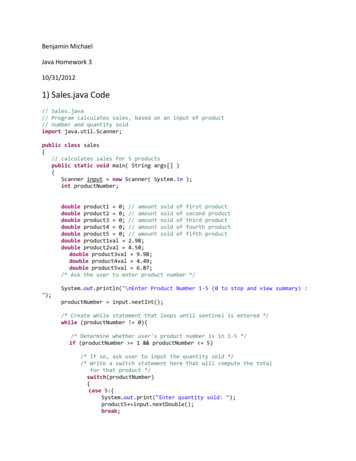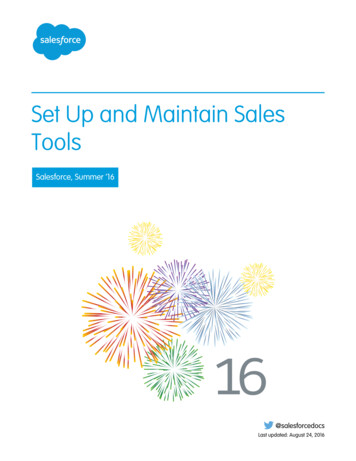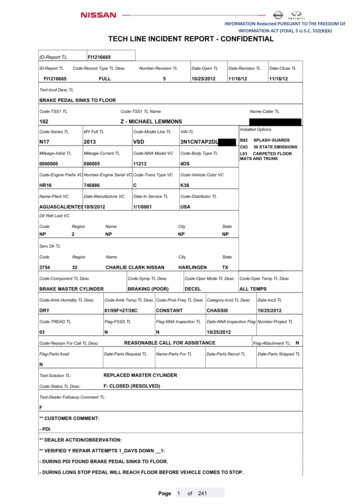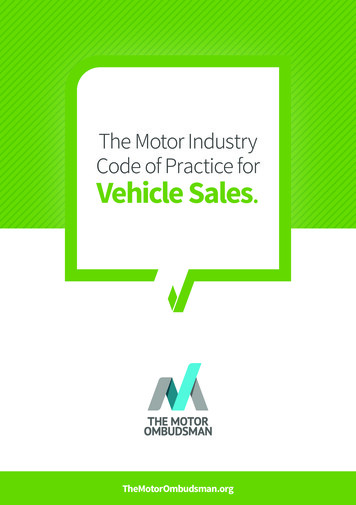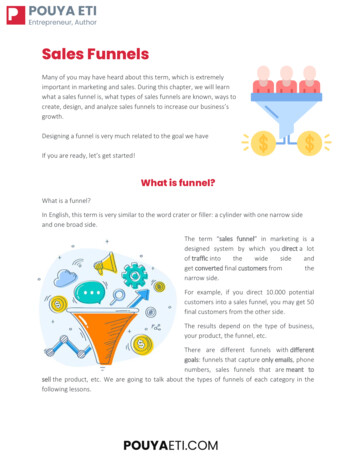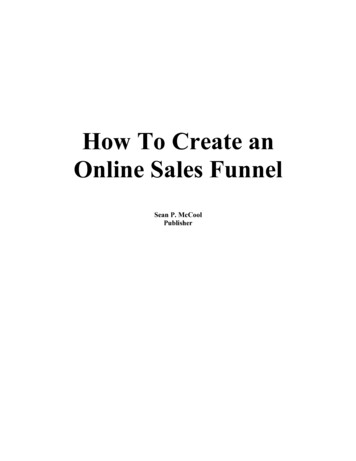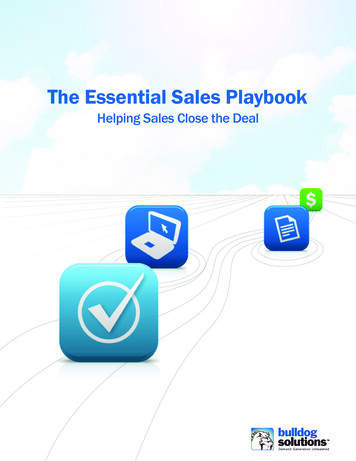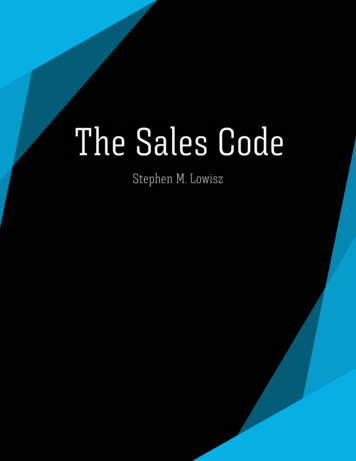
Transcription
The Sales CodeStephen M. Lowisz
The CodeRule #1: Communicate a VisionRule #2: Clarity is the Modern Man’s CurrencyRule #3: The Difference Between Manipulation and Influence is IntentRule #4: You have a Moral and Ethical Obligation to SellRule #5: Know Your ValueRule #6: Keyboard Warriors Never WinRule #7: Require Action2The Sales Code
Read FirstThe Sales Code isn’t a 1990’s sales trainingbook. It is a set of principles I have compiledover years of selling to companies rangingfrom ESPN, Intuit, and Uber, to bothbootstrapped and venture capital backedstartups.These principles have helped me achieve thefollowing: Start closing and consulting Fortune 500clients at 17 years oldClose my first 1M in revenue at 19 yearsoldFeature my clients in publications likeBusiness Insider and BloombergGenerate millions for clients ranging fromSilicon Valley to the UkraineGrow my own highly-skilled team of salesexperts around the globeWhen I started in sales, I started like most. Ihad no idea what I was doing and completelyand utterly failed for the first twelve months.My career started at just age 17. I was doingold-school, smile-and-dial sales. When I gotprospects on the phone, I was so nervousthat I didn’t know what to do. In fact, EdwardJones (currently #376 on the Fortune 500)was one of my first clients and I botched it sobadly that my boss took the entire accountaway from me.However, my continuous failure for twelvemonths wasn't in vain and gave me theexperience and lessons I needed to closedeals. I became obsessed with sales gurus,sales books, etc. By 18 I started to figurethings out, and at age 19, I completed my firstThe Sales Code 1M in annual revenue. Despite my success,there was a problem: my sales methodologysimply wasn’t scalable.It’s one thing if you’re selling 500K solutions– your sales methods don’t need the samescalability as those selling SaaS platformsto small businesses. But, like most sellingsolutions between 20 and 10,000, I neededto figure out a way to scale. I had nearly hit mylimit in sales. I was adamant about coming upwith a scalable, automated solution for closingdeals, so I went on a long, expensive journeyto do just that.I’m a salesman first, marketer second. Toomany, whether in the field of lead generationor pure marketing (aka “growth hacking” - Ihate this term), are focused on KPIs like emailsubscribers, page views, and trial starts. Whilethese can be good indicators that you’regetting some traction, these numbers don’tpay the bills. Very few marketing companiesare focused purely on driving revenue, witheverything else coming secondary. My desirewas to come up with a solution that leveragedmarketing and “growth hacking” strategies,but ended up with me closing deals, not withpointless traffic or free trials that wouldn’tconvert.There were two truths I realized very quickly:1. Cold calling wasn’t scalable2. Technology alone can’t close B2B dealsThe exception to #2 is if you have anextremely low-ticket item. And even then,hiding behind a keyboard isn’t typically the3
way to go.I inundated myself with automation tools,marketing methodologies, and creative leadgeneration processes to figure out how tobest fill my funnel and keep me closing deals.I had an extremely high closing ratio, butI couldn’t keep the pipeline full. After trialand error and paying 125,000 in coaches,trainers, and mentors, I finally found how toscale.I started testing these strategies in my owncompany as well as with clients, and theresults were incredible. We closed millionsof dollars, got some of our clients fundedby Y-Combinator, and saw 150% growth in 6months with others.Now, instead of keeping this methodologyinternal, I’m on a mission to expose the salesand marketing industry for the spam-driven,results-lacking bullshit that it has become. Thismeans I’m willing to give out the principlesI use to close deals and scale clients aroundthe globe in this Sales Code, thereby openingthe door for you, your team, and companiesworldwide.4The Sales Code
Rule 1: Communicate a VisionThe ProblemWhen was the last time you scrolled throughFacebook or Instagram and didn’t feel like youwere bombarded with the same garbage overand over? When is the last time you actuallygot a sales email in your inbox that didn’tmake you want to vomit? And when is the lasttime you joined an over-done webinar thatbrought you value, not just a sales pitch?We know theoretically that our target as salespeople, marketers, and business owners is todrive value. However, in our everyday lives,we throw this idea right out the window. Toomany are trying to use sports cars, models,and buzzwords to engage their audience. Aperfect example of this garbage is how guyslike Tai Lopez market. They will literally rentall of the above and sell you courses andproducts based upon fraud.As politically incorrect as I’m about to get, itneeds to be said: marketers and salespeopleare treating their prospects like dogs. Dogsget excited for a moment by a squirrel butlose interest when another one pops up.Marketers use these bullshit tactics to brieflygrab their prospect’s attention just longenough to swindle their money before theymove on to the next “squirrel.”The reason for this stems from a combinationof issues, which will be covered later in-depth.However, there’s one main problem:The Sales CodeMarketers and salesprofessionals can’t communicatea vision to the marketplacewhen they themselves have lostsite of what their vision was inthe first place.Let me put this into context. At my company,our vision is to change the sales andmarketing industry from the inside out.Almost every small business owner I havemet has been royally screwed by a marketingagency, PR firm, or lead generation company.Integrity and meaningful results are nowhereto be found. Unfortunately, this has anenormous ripple effect.If a small business spends their money ona marketing agency that takes that moneyand runs (which happens every damn day),that small business could have to lay offemployees or, even worse, shut down.If you work with a lead generation companythat promises to drive leads every day toyou, but they’re unqualified and impossibleto converto, you are in the same boat as thesmall business that got screwed by an agency.Conversely, if my team and I grow just onesmall business, or in our case, one techstartup, the ripple effect is also huge. We’reable to provide more jobs internally, moreopportunity for our clients, and greater valueto their clients. That is what drives us. We are5
an aggressive brand ready to leave our markon an industry that has become complacentand accustomed to cheating companies outof money. It’s a vision so ingrained in ourorganization that it’s infectious.We may have given a developer from theUkraine a new opportunity to advancethemselves and their family than ever before.The potential to give a single mom tryingto make ends meet a real, legitimate jobis also there. Talk about vision. If we helpone company, we help many individuals.Individuals turn into families. Families turninto communities, and the ripple effectcontinues.People don’t work with us because we useterms like “growth hacking” (there’s no hackto real growth!); they work with us becausewe share a common vision to dent themarketplace.Let me give you a little story I was on thephone with a client not too long ago. He wastelling me how he’s a technical Founder withzero sales and marketing ability. He built agreat platform that could affect millions oflives, yet according to him, he was incapableof delivering it to the market. He had a vision,but no way to execute until I slapped him inthe face with what he had just said.marketplace?” Of course, he immediatelyresponded, “Yes”. I shot back, “Great, soyou’re a marketer and salesman.” His reactionwas priceless. He knew I was right.My ability to sell doesn’t come from knowinghow to sweet-talk someone. It comes frommy ability to communicate my vision for ustogether. I don’t work for people. I work intandem with people. Why? Because I holdthe vision my clients desire. I hold the visionof a scaled business, taking their products tothe masses, and providing opportunity for all.They want what I have.Action StepYour sales approach and marketing tacticsmust change immediately. Take a look at youremail copy, cold call approach, and digitaladvertisements. Are they focused on featuresyour product has? Are they focused on whatyou do and how you do it?Your prospects don’t care what you offer. Theycare about what vision you hold.Analyze your efforts so far and see whatvision is being communicated, if any. Moreoften than not, your materials and tactics arefocused on what you do and how you do it.You need to drop all of this.See, marketing isn’t about knowing tacticsand using the right buzzwords. It’s not evenabout design (although, yes, it helps). It’sabout communicating your vision to themarketplace as well as what your solution willdo for that individual.So, when I spoke with this tech Founder, Isimply asked, “Are you capable of sharingyour vision and what you’re doing for the6The Sales Code
Ask yourself these questions: Why did you start your business (or job ifyou work for someone else)? Why do you get up every morning andgrind every single day? What is the impact your company couldhave on the marketplace? Why should people care about what youcan do for them?These questions will start to guide you towardan approach that delivers value and vision.People want new opportunities. They don’twant the same bullshit everyone else is givingthem.Value isn’t pitching a brand. It’spresenting a new opportunity, anew vision.The Sales Code7
RULE #2: Clarity is theModern Man's CurrencyThe ProblemAt this point, we can all agree that a clearvision is what sells. It’s a fact. Which thenleads us to a very important question: why isthe market so noisy and complex?When you lack vision, you endup bringing nothing more thancomplexity to the market.Without vision, you have nothing more tosell than features, services, integrations, etc.These simply don’t sell. What you do does notmatter; it’s simply a vehicle to reach a vision.Without a vision, you have nothing more tosell than superficial features no one genuinelycares about.When I first got started in sales, this was theepitome of what I would do. I wanted tosimply blurt out everything the consultingfirm I was working for could do for the client.When you’re the Head of Human Resourcesat a Fortune 100 company, it’s safe to say youtruly don’t give a rat’s ass about solutionsa vendor can provide. All you care aboutis a vision of how life could be withoutexperiencing the pain and problems youcurrently have. I’d rattle off everything I couldpotentially do for these executives, whichresulted in an extremely low closing rate.Things started to change when I’d shut mymouth and listen. I started to ask questionsto understand what the individual on the8other end truly cared about. About 99% ofthe time, only one solution I could offer was afit. Meaning, we spent the entire time on thatsolution, because it was the most relevant,easiest way to solve the individual’s pain and,therefore, made my closing rate skyrocket.Let’s put this into context of selling atechnology solution. I was on two demosthat were back to back. I was interested intwo different SaaS platforms, so I set up 30minutes with both. These calls went nearlyidentical. The worst part? It was clear that theywere both following scripts.They both followed this sequence:1. Tell the prospect why they are an awesomesolution.2. Do a demo of the product’s most basicfeatures.3. Run out of time and try to set up 30 moreminutes.You might be laughing, but this is all toocommon. If you’re not laughing, there’s abigger concern here.Let me point out where they went wrong:1. They asked zero questions to understandwhat I wanted to really learn about.2. Neither company could relate theirproduct to my company.3. Both sales “experts” rambled on so much,they had to set up another meeting just toask for the sale.The Sales Code
It’s safe to say neither company got anothercall with me, let alone a sale. They showedlittle interest in doing anything morethan taking my money and collecting acommission. That doesn’t fly with me. Likemy clients, I only partner with those thatshow professionalism, customer service, anda genuine interest in the value I can receivefrom them.Here’s the funny part: I was just like thesetwo sales reps I’m now poking fun at. I was agarbage salesman that was selling complexityinstead of a vision. Here’s what I realized,which helped lead me to closing my first 1Mat such a young age:Clarity is the modernman’s currency.The SolutionNow, I have to give credit where it is due. Theactual phrase was not coined by me. One ofmy mentors, Garrett J. White, is the one thatdeveloped this clear and concise phrase. Atthe most basic level, it simply means thatpeople buy clear, simple, specific solutionsto their problems. The second you throwyour features, services, etc. into the mix, youvoid this entire formula. For all intents andpurposes, the investment is returned whenyou bring clarity into someone’s life.of MP3 players on the market. Their vision wasto put 1,000 songs into your pocket with onesimple device. That vision gave the feeling ofbeing rebel, while delivering a clear solutionto the issue of carrying clunky devices andoutdated technology around.This vision was so compelling, we have what Inow call “Apple crack.” Why? Because peopleconsume their technology like a drug. If youput an iPhone next to the latest Samsung,the iPhone will lose nearly every time whenit comes to the hardware specifications.Typically, they’re about two years behind theAndroid when it comes to features. However,when they do finally catch up on features, theydo it in the clearest, simplest way.My grandma has an iPhone. If I gave her anAndroid, she wouldn’t know what to do. Theyare more complex and feature-driven. Applehas stayed true to their vision by enablinganyone and everyone to experience the joysof technology in the simplest way possible.Everything they do is driven by clarity andsimplicity.This same principle goes for my company. Isthe client who wants to scale revenue by 150%in 2 months the same as the client who desiresto be featured in an exclusive by BusinessInsider? Not a chance. These two are feelingdifferent pain points, therefore, desiringdifferent visions. It would be pointless to sellthe sales-driven client on guerrilla marketing,sales training intensives, or PR services.Let’s look at the most cliché example of avision clearly and simply communicatedto the marketplace – just look at Apple. Ifyou haven’t seen it, take a look at the firstcommercial Steve Jobs launched. Theywanted to destroy the Walkman and dozensThe Sales Code9
Action StepYou defined your vision based on Rule 1 ofThe Sales Code. Now it’s time to sell clarityupon the foundation of your vision.Make it very practical and actionable byasking yourself the following questions: Are your prospects 100% clear on thesolution, not the features, you’re bringinginto their life?Do your prospects understand the rippleeffect that could happen in their life if theypartner with you?Do you have a full understanding of whoyou are and what you stand for?Can you convey that understanding toyour clients and prospects in an effectiveand meaningful way?The quality of the questions you ask in yourlife will, in large part, determine the qualityof your life. This applies to business as well.If you can ask these challenging questionsand communicate the answers to your targetmarketing, you become unstoppable.While your competitors continue selling andmarketing to their prospects in complex,confusing ways, your target market will start tobe intrigued by the clarity you bring into theirlives. The best part is this type of interest andintrigue will overcome the “shininess” foundin your competitors’ short-term attentiongrabbers.Answering powerful questionswill bring powerful results.10The Sales Code
RULE #3: The Difference BetweenManipulation and Influence is IntentThe ProblemNo one likes to be manipulated. In fact,when we realize someone is doing just that,we get a sour taste in our mouths and wantnothing to do with that individual. Yet, whatwe often forget is we’re being manipulatedevery single day. The “shiny” colors, features,and keywords I keep referring to are waysmarketers and sales professionals manipulateus.Sorry, but an incredible advertisement can’tmake up for the lack of value brought througha solution. Yet, too many are convinced thisworks. They aren’t operating by a code likeyou now are, so they manipulate others intobuying from them any way they can.The most practical example of this is pricing.Do you sell based on pricing? Here’s a reallyeasy way to tell – you negotiate pricing withyour prospects the second they give youpushback. Maybe you throw in free servicesor products to “sweeten” the deal. All of thisis garbage, and it stems from an inability tocommunicate real value.“The price is too high” is acomplaint, not a legitimateproblem.Those that struggle because they haven’tbeen able to communicate a clear andconcise vision, as we’ve already discussed,then resort to manipulation. Why do we call itThe Sales Code“price manipulation”? It’s due to the fact ourintent is to get more cash in our wallets, notto bring value. If our intent is to bring morevalue, we’d charge more. Yes, you read thatright.People don’t value free or cheapsolutions. The end.Do you value a free webinar? No, you’restatistically likely to not even show up. Do youvalue a “free shipping” offer? Likely, no. Youthrow the book you just ordered in a drawerand forget about it.On the other hand, do you value a platformyou pay 1,000 per month for? Absolutely.You’re not going to go a day without usingit. Do you value a coach you pay 10,000 permonth to? The answer is 100% yes. You’regoing to treat that coach far differently andvalue the advice they give you far more thanone you pay 2,000 over 12 months to.The difference betweeninfluence and manipulation isintent.11
The SolutionWhen you want someone to truly get valueout of something, you need leverage onthem. Pricing is a great way to get leverage. Ifyou’re choosing to cut pricing just to land thenext deal, it is a 100% guarantee that you’rein it for the cash. It’s manipulative. On theother hand, if I’m 100% sold on turning a clearand concise vision into a reality for a client,it is now my responsibility to influence theclosing of the deal at the price I pre-set.The difference is one word: intent. Too manymarketers and salespeople are chasingmoney, and it’s bastardizing the entiremarketplace. I tell more clients “no” thanI do “yes”. If you look at my website, youhave to apply to work with me in most of myprograms and solutions. It’s for one simplereason: I’m doing my prospects a disserviceby wasting either of our time if I can’t bringvalue to them in the way they need, or theysimply can’t afford to invest at a price thatbrings mutual value.Yes, you are entitled to value in anyrelationship, professional or personal.Relationships aren’t a one-way street. If youhave a kick-ass platform you’re delivering tothe market, you are entitled to charge for it.And frankly, if you undercut yourself, not onlywill the prospect not take it as serious and getout of it what they otherwise could, but youlose motivation over time to serve that clientto your utmost ability. Do both of yourselvesa favor and refer the client to a competitorif you aren’t correctly aligned in a mutuallybeneficial relationship. Stop trying to work forcompanies and start focusing on working as apartner.12This does several things:1. It keeps your integrity in line, becauseyou’re no longer focused on the money.You’re focused on transforming a visioninto a reality for the client.2. It forces the client to respect you or yourproduct in your given field, which createsmore satisfied and lower-maintenanceclients.3. The brand of your company isn’t tarnishedby low prices and manipulative salestactics. No one respects the lowest-costprovider. The second a lower-pricedsolution comes to market, your customerwill leave.Want to run a miserablecompany? Cheapen yourselfand manipulate yourprospects.Action StepsNot being a manipulative dirt-bag is hardwhen that’s essentially what sales andmarketing leaders have more-or-less taughtus to be. We’ve been indoctrinated with howto write the same sales copy with the samekeywords and bullshit as each other.The Sales Code
Instead, check yourself and ask the followingquestions: When you get on the phone with aprospect are you already thinking aboutthe cash a closed deal will bring? Can your competitors serve your prospecta better solution for what they truly need?If so, are you willing to refer them insteadof closing a deal? Do you negotiate price with yourprospects, or strictly hold to your pricing?Intent is a world-changing difference.The intent is the difference between the“marketing guru” trying to sell you onexpensive, unhelpful courses that do nothingmore than make them rich and the industryleader making legitimate changes in themarketplace through integrity.Be the breath of fresh airin your industry by bringintegrity back into it.The Sales Code13
RULE #4: You Have aMoral & Ethical Obligation to SellThe ProblemOne of the biggest problems sales peopleand entrepreneurs have is they’re hesitantto close. They often feel ashamed toask, like they’re begging. I even speakwith entrepreneurs that have built mastertechnology platforms but look at it as a loadof crap. We never like our own work as muchas someone else’s, which bleeds into ourability to sell.The SolutionTo top it off, no one likes rejection, meaningit’s easy to get anxious about asking for theclose confidently. We will avoid rejectionat all costs, which can even go as far assimply not asking for the close to avoid theembarrassment. then it becomes your moral and ethicalobligation to close the deal. This might seemradical, but it is a fact.We’ve all been on calls where we’re anxiousand stressed about a deal, and the prospectcan read it. They feed off of our energy 100%of the time. If you give off the impressionand energy that what you’re selling is at adeal-breaking price, then your prospects willalready be making assumptions and gettingready to say no before you even come aroundto the pitch.Those that sell withintegrity should never beashamed of asking for cash.If you’ve Communicated a vision the target marketwants Brought clarity and simplicity into yourprospect’s life.Influenced your prospect based onintegrity and value Let’s say someone holds your key to the futureyou desire, they have your best interest inmind, and they’ve brought simplicity into yourlife. You’re waiting for the sale and are readyto throw down your credit card, but theychicken out. They never make the ask, nevergiving you the opportunity to change your lifeor your business. Wouldn’t that suck?Consider the possibility that you hold thefuture your prospect wants and it’s yourobligation to bring that future to them. It’syour job to set it in their lap and ask themto pay for it. We’ve already established thatgiving something away for free is a disserviceto your prospect.Based on the situation you’re in, you owe itto your prospect to sell them. You’ve dangleda carrot in front of them, and now it’s time toleverage that to bring change in their life.Think about the ramifications of notcommitting your prospect to a close. You’re14The Sales Code
telling them that your feelings of awkwardnessand anxiety are a greater priority than trulyhelping them. You’re letting them knowyou hold the solutions they need but aren’tcommitted enough to it to sell it. Talk about aturn off and a waste of time on both sides.Action StepThis is simple. If you believe in your product,have brought value, and have done so withintegrity, it’s your obligation to deliver yoursolution to as many people as possible. Tonot do so is to be selfish and keep your visionto you alone. The action step here is quitesimple.Ask yourself the following: Have you followed The Sales Codeprocess up to this point? Do you believe in your product?Then It is your moral and ethicalobligation to close deals!The Sales Code15
RULE #5: Know Your ValueProblemThe toughest problem I had to deal with,out of everything, when I started selling wasselling from an inferior standpoint. My jobat just 17 years old (while I was still in highschool!) was to sell to Fortune 100 and 500executives. I remember walking into my firstmeeting in New York City with a stomachache from anxiety. This happened the firstseveral times I had meetings with the likes ofNew York Life Insurance, CBRE, etc.You need the deal. You must close it. You’realready picturing what will happen if you do.However, this mindset creates dependencywhich turns into scarcity.Thankfully, I wasn’t alone in those firstmeetings, or I would’ve failed miserably. WhatI found after hundreds of phone meetingsand overall sales pitches, most of which werefailed with a few successes sprinkled in, is thatpeople don’t want to be sold. It’s a brilliantand original concept, I know. What I mean is that people don’t want to bechased. They don’t want to feel like they’rebeing sold. After numerous methods to getaround this, I had the genius idea to talk tothese executives like they were just people. Inreality, they are. That’s it. We all put our pantson the same way as one another.The issue this stems from is our desire tomake cash. There is nothing inherently wrongwith making money. However, as discussedbefore, if that’s our sole intention, we enterthe realm of manipulation and even scarcity.It’s the idea that the next deal will make orbreak you.16This issue has a ripple effect in and of itself: You can’t sell from a place of scarcity – theclient can feel it subconsciously and turnsaway.People don’t buy from you when theysense you’re chasing them.You’re coming from a state of inferioritywith a strong dependency on the sale,which screws with your own mental state.ou start to get back into the pricemanipulation game, which then de-valuesyour solution.I remember the first time I actually had aprospect lined up for the consulting companyI was at. I was chasing down a mid-levelmanager at a Fortune 500 company forfour weeks. The guy was what’s wrong withcorporate America. He scheduled sevendifferent phone meetings with me, most ofwhich were after hours due to a time zonedifference, and he didn’t show up for any ofthem.I was pissed, frustrated, and felt takenadvantage of. I kept chasing him instead ofhaving dignity.He had me in a submissive, inferior state,and I played along with it. Now, when I havea prospect who lacks professionalism by notresponding or who wants to screw me whenit comes to pricing, I simply let them knowThe Sales Code
that I’m no longer interested in working withthem. Sure, I’ll follow up once or twice, but itends there.You must choose abundanceover scarcity in everydeal, negotiation, andconversation.SolutionThe solution is easy when you have alreadyfollowed the previous rules of The SalesCode. If you hold the future your prospectwants in the palm of your hand, you’ve soldthem on a clear and simple solution, you’veinfluenced action through a clear and nobleintent, and you understand it’s your moral andethical obligation to close the deal, the restbecomes easy.When you start to have dignity andunderstand that 1. there are more clientsout in the world and 2. you don’t need totake bullshit from one, you enter the land ofabundance as opposed to scarcity. Let meclarify: I’m not talking about not serving yourcustomers with the utmost professionalismand going above and beyond to deliver. Notat all. What I’m talking about is not being ata prospect’s mercy or letting them hold theframe.A frame is the perspective or set ofexpectations on which a particular scenarioor relationship is built. The frame defines thedynamic of the situation. You can be in myThe Sales Codeframe, or I can be in yours. When you’re in myframe, you play by my rules on my terms. Thisis how I operate. Your prospects need to playby your rules. Why? You’re the expert and youhold the vision they desire. If they want to callthe shots, they don’t actually want help. Theycan find someone else.Far too many prospects think they know whatthey want, and they believe they know how toget there. If that was the case, they wouldn’tbe calling you, as they would’ve already fixedthe problem. You need to break this idea andput them in your frame, putting you on a peerto-peer level (as opposed to a boss-to-workerarrangement), which is what this is all about.When sitting across from a CEO of a smallbusiness or an executive in a Fortune 500company, you are at a one-to-one level. Theyare no better than you. You are no better thanthem. You are there to see if a partnership iswhat makes sense for your organizations. Ifnot, hey, no sweat. It’s okay. There are moreprospects, more clients to close, and moremoney to be made.It is indisputable that thereis enough money in theworld to go around. Stopchasing one dollar whenthere are trillions morein circulation ready to beyours.17
Just recently I was speaking with a prospectthat called an audible at the last second. Aftersending him a contract we both agreed to, hedecided he wanted to pay me 20% less.If I was in it for the money, I would’ve saidyes. However, I know that to keep my integrityintact I had to turn the opportunity down. Ihad a bad taste in my mouth, he was testingme to see if I was willing to chase him, and Iwould’ve devalued my own work. In addition,he would’ve become what we all know as “theclient from hell”.It’s better to say no to onedollar so you can focus onmaking ten.Action StepThe action step for rule #5, like all of theothers, is quite easy. It’s gaining the ability tochoose abundance
or pure marketing (aka “growth hacking” - I hate this term), are focused on KPIs like email subscribers, page views, and trial starts. While these can be good indicators that you’re getting some traction, these numbers don’t pay the bills. Very few marketing

